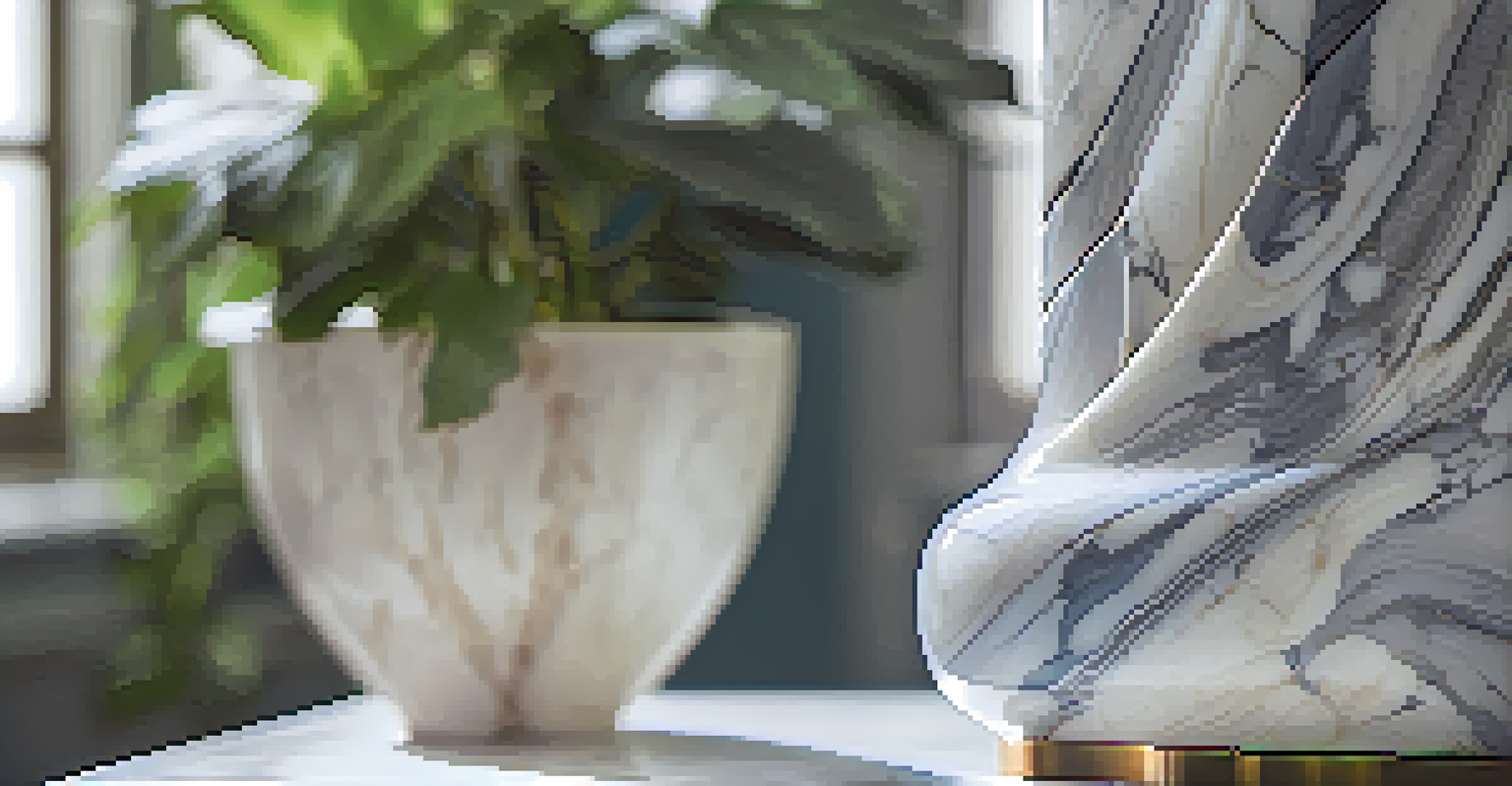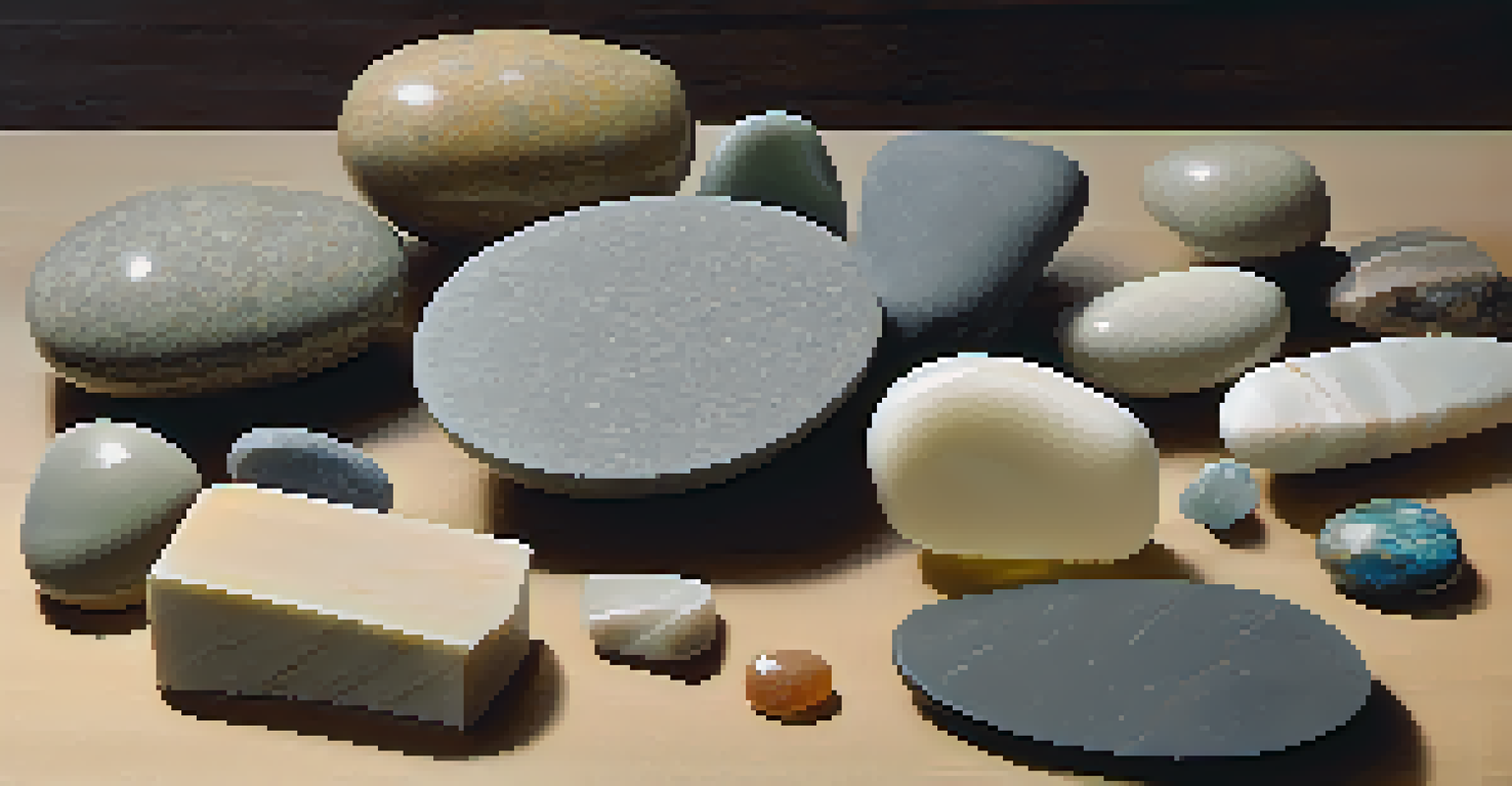Understanding the Different Finishing Techniques in Stone Carving

Introduction to Stone Carving Finishing Techniques
Stone carving is an ancient art form that requires skill and patience, especially when it comes to finishing techniques. These techniques not only enhance the beauty of the sculpture but also affect its durability and overall appeal. Understanding these methods can help both artists and enthusiasts appreciate the craftsmanship involved in each piece.
Art is not freedom from discipline, but disciplined freedom.
Finishing techniques can vary widely, depending on the type of stone used and the desired outcome. From polishing to texturing, each method serves a specific purpose, whether it's to highlight natural patterns or create a smooth surface. The choice of technique often reflects the artist's vision and the message they wish to convey through their work.
As we delve into the various finishing techniques, it’s essential to recognize that each one has its own set of tools and processes. This exploration not only broadens our understanding of stone carving but also inspires us to see these creations in a new light.
Polishing: Achieving a Smooth, Reflective Surface
Polishing is one of the most popular finishing techniques in stone carving, known for giving sculptures a glossy, reflective surface. This process typically involves using abrasives and polishing compounds to buff the stone until it shines. The result is not only visually striking but can also enhance the stone's natural colors and patterns.

The polishing process can vary depending on the type of stone. Softer stones like soapstone can be polished relatively quickly, while harder stones such as granite may require more intensive labor and specialized tools. This difference highlights the importance of selecting the right approach based on the material at hand.
Importance of Finishing Techniques
Finishing techniques in stone carving enhance both the beauty and durability of sculptures, showcasing the artist's skill and intention.
Ultimately, polishing doesn’t just improve aesthetics; it also protects the stone from environmental factors. A well-polished surface is less prone to accumulating dust and grime, ensuring that the artwork remains beautiful for years to come.
Honing: Creating a Soft, Matte Finish
Honing is often compared to polishing, but instead of a shiny finish, it produces a soft, matte surface. This technique is achieved by using finer abrasives to create a smooth texture without the reflective qualities of polishing. Honed surfaces can give sculptures a more natural and understated look, which some artists prefer.
Every artist was first an amateur.
This technique is especially popular for architectural elements and countertops, as it offers a more subtle elegance. Additionally, honed finishes can be more forgiving in terms of showing wear and tear, making them ideal for high-traffic areas. It gives the stone character while still maintaining its integrity.
Another advantage of honing is that it can enhance the stone's tactile quality, inviting touch and interaction. This is particularly important for sculptures intended to be experienced up close, allowing viewers to connect with the artwork on a deeper level.
Texturing: Adding Depth and Interest
Texturing is a finishing technique that adds depth and visual interest to stone carvings. This can be achieved through various methods, including chiseling, sandblasting, or using specialized tools to create patterns and designs on the surface. Textured finishes can evoke different emotions and draw the eye in unique ways.
The choice of texture can reflect the artist's intent or the theme of the piece. For instance, a rough, rugged texture might convey strength and resilience, while a smoother texture could suggest elegance and grace. This versatility allows for immense creativity in stone carving.
Polishing vs. Honing Explained
Polishing creates a glossy finish while honing results in a soft, matte surface, each serving different aesthetic purposes.
Furthermore, textured finishes can also play with light and shadow, enhancing the overall composition of the sculpture. This interplay can create a dynamic viewing experience, where the piece changes in appearance depending on the viewer's angle and the light conditions.
Chiseling: The Art of Manual Finishing
Chiseling is one of the oldest techniques in stone carving, involving the use of chisels and hammers to shape and refine the stone. This method allows artists to create intricate details and smooth finishes, depending on their technique and the tools used. It requires a steady hand and a keen eye, making it a true test of craftsmanship.
One of the unique aspects of chiseling is that it can create both polished and textured finishes, depending on how the tool is applied. For example, light taps can yield a smooth surface, while heavier blows can produce a rougher texture. This adaptability makes chiseling a fundamental technique in the stone carver's toolkit.
Moreover, chiseling offers a personal touch to each piece, as the artist's skill and style are evident in the finished work. This connection to the artist's hand can make each sculpture feel alive and imbued with character, further enhancing its value and appeal.
Burnishing: A Traditional Finishing Technique
Burnishing is a traditional finishing technique that involves rubbing the stone’s surface with a hard tool, often made of metal or another hard material. This process compresses the stone's surface, resulting in a smooth, glossy finish without the use of abrasives. It's a time-honored method that dates back centuries and is still appreciated today.
The burnishing technique can be particularly effective on softer stones such as alabaster or marble. It enhances the stone's natural beauty, bringing out colors and patterns that might otherwise go unnoticed. This technique not only improves aesthetics but also adds a layer of protection to the stone’s surface.
Sealing for Long-Term Protection
Sealing is essential for protecting stone carvings from damage and preserving their appearance over time.
Interestingly, burnishing can also create unique textural effects, depending on the pressure and technique used. The result is a finish that is both beautiful and functional, making burnishing a valuable technique in the stone carver's repertoire.
Sealing: Protecting and Preserving Stone Carvings
Sealing is a critical finishing technique that involves applying a protective coating to the stone surface. This process helps to prevent staining, moisture damage, and weathering, ensuring that the artwork remains in pristine condition for years to come. It’s especially important for outdoor sculptures that are exposed to the elements.
There are various types of sealants available, each designed for different stone types and environments. Some sealants are breathable, allowing moisture to escape without causing damage, while others are more robust, providing a strong barrier against harsh conditions. Understanding the right sealant for the specific stone is vital to effective preservation.

In addition to protection, sealing can also enhance the stone’s appearance by deepening its color and adding a subtle sheen. This dual purpose makes sealing an essential step in the finishing process, ensuring that the artwork not only looks great but also stands the test of time.
Conclusion: Embracing the Art of Stone Finishing Techniques
In summary, understanding the various finishing techniques in stone carving deepens our appreciation for this ancient art form. Each method, from polishing to sealing, plays a crucial role in enhancing the sculpture's beauty and longevity. By exploring these techniques, we can better understand the skill and dedication that artists pour into their work.
Whether you’re an artist or an admirer of stone carvings, recognizing the importance of finishing techniques can enrich your experience. These methods are not merely technical steps; they are integral to the storytelling and emotional impact of the artwork. Each finish brings its own character and charm to the piece.
As you explore the world of stone carving, remember that the finishing touches are what truly bring a sculpture to life. Embrace the artistry involved in these techniques, and you’ll find that every stone carving tells a unique story worth discovering.